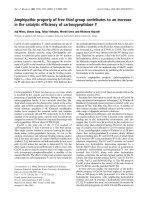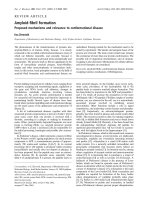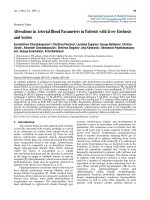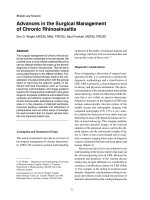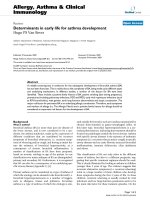Báo cáo y học: "Microcirculation in cardiogenic shock: from scientific bystander to therapy target." doc
Bạn đang xem bản rút gọn của tài liệu. Xem và tải ngay bản đầy đủ của tài liệu tại đây (274.39 KB, 3 trang )
Despite diagnostic and therapeutic improvements,
cardiogenic shock (CS) is still the most common cause of
death in patients with acute myocardial infarction.
Although percutaneous coronary intervention (PCI),
inotropes, fl uids, adjunctive medication, intra-aortic
balloon pump (IABP), and ventricular assist devices are
widely available, mortality rates in patients with CS
remain high (40% to 50%). erefore, Munsterman and
colleagues [1], whose investigation of the micro circu-
lation in patients with IABP was reported in the previous
issue of Critical Care, have addressed an important topic.
In the last fi ve years, an important body of knowledge
showing the pathophysiological importance of the micro-
circulation in the development of multiple organ failure
in critically ill patients has been built up. is has been
made possible because of the development of novel
techniques to either directly visualize or indirectly
evaluate microvascular perfusion [2]. In CS, micro vas-
cular alterations have been observed, resulting in a
decrease of vessel density, the proportion of perfused
capillaries, or microvascular fl ow [3,4]. Diff erent treat-
ment strategies, including pharmacological interventions
and mechanical assist devices, may lead to microcircu-
latory improvement in CS [5-7].
In their article, Munsterman and colleagues show that
in patients deemed ready for dis continuing IABP
support, microcirculatory fl ow in small vessels increases
after ceasing IABP therapy. e authors conclude that
IABP impairs microvascular per fusion in hemo dy-
namically recovered patients. ese impor tant fi ndings
not only highlight the need for optimal timing of weaning
from IABP support but also demonstrate that global
hemodynamics do not necessarily result in changes of
microvascular perfusion [8,9]. In theory, IABP improves
peak diastolic pressure and this may also translate into
better microcirculation. Although suffi cient cardiac
output and arterial pressure are prerequisites for ade-
quate microvascular perfusion, their relationship is very
complex. Changes in micro vascular vessel density and
fl ow, their heterogeneity, autoregulation, and response to
therapeutic interventions might be dissociated from
systemic eff ects [2,9]. Furthermore, with the knowledge
of the study by Munsterman and colleagues, it is
obviously important to realize that, depending on the
stage of the disease course, an intervention has diff erent
eff ects on the microcirculation.
Modern therapy of CS consists of an adequate regime
with revascularization, drug treatment, and mechanical
support [10]. Although there is no question about the
Abstract
Despite diagnostic and therapeutic improvements,
mortality rates in patients with cardiogenic shock
remain relatively high. Several studies showed that
cardiogenic shock is associated with alterations in
the microvascular circulation. These alterations may
be reversed by extracorporeal support devices. A
study by Munsterman and colleagues adds to the
body of evidence showing that in patients deemed
ready for discontinuing intra-aortic balloon pump
(IABP) support, microcirculatory ow in small vessels
increases after ceasing IABP therapy. This study not
only highlights the need for optimal timing of weaning
from IABP support but also supports recent ndings
that global hemodynamics do not necessarily result
in changes of microvascular perfusion. All modalities
of modern treatment in cardiogenic shock need to
be evaluated for their e ect on the microcirculation.
Microcirculatory evaluations should be part of
randomized controlled trial protocols. More e ort is
needed to improve outcomes and understand the
microcirculation as a therapy target and not as a silent
bystander.
© 2010 BioMed Central Ltd
Microcirculation in cardiogenic shock:
fromscienti c bystander to therapy target
Christian Jung*, Alexander Lauten and Markus Ferrari
See related research by Munsterman et al., />COMMENTARY
*Correspondence:
First Department of Internal Medicine, (Cardiology, Angiology, Pneumology,
Intensive Care Medicine), Friedrich-Schiller University, Erlanger Allee 101,
07740Jena, Germany
Jung et al. Critical Care 2010, 14:193
/>© 2010 BioMed Central Ltd
survival advantage of early revascularization and its
benefi cial consequences for the macrocirculation, there is
no systematic study on its eff ects on microcirculation.
However, revascularization reverses the spiral of
progressive left ventricular dysfunction and therefore is
understood to improve the microcirculation.
Diff erent drugs, particularly fl uids, vasopressors, ino-
tropes, levosimendan, and vasodilators, infl uence the
hemodynamics of patients with CS. e administration
of fl uids in CS is based mainly on pathophysiological
considerations and has not been studied in adequate
randomized clinical trials. No data regarding fl uid
adminis tration and microcirculatory changes in the
setting of CS are available. Similar to fl uid administration,
the choice of vasopressor and inotropic therapy is based
mainly on individual experience and institutional policy;
furthermore, this choice diff ers between guidelines.
However, vasopressors might be able to stabilize the
mean arterial pressure, but their use has negative
consequences for the perfusion within microvasculature
[11]. In small observatory studies, benefi cial eff ects on
microcirculatory indices in CS have been described for
levosimendan and nitro glycerin [5,12].
Owing to the lack of evidence for the use of IABP in CS
after successful revascularisation of occluded infarct
vessels, its role remains controversial. To date, there is no
adequately powered randomized clinical trial available,
and knowledge is based on observational trials or trials
before the era of primary PCI. IABP support improves
microvascular fl ow in unstable patients; however, diff er ent
time points of the disease seem to be of importance [6,9].
Figure 1 summarizes therapeutic strategies aff ecting
micro vascular perfusion in CS. All interventions should
be evaluated for their eff ect at the microcirculatory level.
Microcirculatory evaluations need to be part of random-
ized controlled trial protocols. Guiding inter-individual
modern therapy of CS with in vivo visualization tools
may allow a more specifi c and appropriate therapy
regime and improve outcomes. More eff ort is needed to
understand the microcirculation as a therapy target and
not as a silent bystander.
Abbreviations
CS, cardiogenic shock; IABP, intra-aortic balloon pump; PCI, percutaneous
coronary intervention.
Competing interests
The authors declare that they have no competing interests.
Published: 6 September 2010
References
1. Munsterman LDH, Elbers PW, Ozdemir A, van Dongen EP, Van Iterson M,
InceC: Withdrawing intra-aortic balloon pump support paradoxically
improves microvascular ow. Crit Care 2010, 14:R161.
2. De Backer D, Ospina-Tascon G, Salgado D, Favory R, Creteur J, Vincent JL:
Monitoring the microcirculation in the critically ill patient: current
methods and future approaches. Intensive Care Med 2010 Aug 6.
[Epubahead of print].
Figure 1. Treatment strategies a ecting macrovascular and microvascular perfusion in cardiogenic shock. E ect of treatment strategies on
microcirculation: solid arrow, positive e ect; dotted arrow, negative e ect. ECMO, extracorporeal membrane oxygenation; IABP, intra-aortic balloon
pump.
Jung et al. Critical Care 2010, 14:193
/>Page 2 of 3
3. De Backer D, Creteur J, Dubois M-J, Sakr Y, Vincent J-L: Microvascular
alterations in patients with acute severe heart failure and cardiogenic
shock. Am Heart J 2004, 147:91-99.
4. Jung C, Ferrari M, Roediger C, Fritzenwanger M, Goebel B, Lauten A, Pfeifer R,
Figulla HR: Evaluation of the sublingual microcirculation in cardiogenic
shock. Clin Hemorheol Microcirc 2009, 42:141-148.
5. den Uil CA, Lagrand WK, Spronk PE, van der Ent M, Jewbali LS, Brugts JJ, Ince
C, Simoons ML: Low-dose nitroglycerin improves microcirculation in
hospitalized patients with acute heart failure. Eur J Heart Fail 2009,
11:386-390.
6. Jung C, Rodiger C, Fritzenwanger M, Schumm J, Lauten A, Figulla HR, Ferrari
M: Acute micro ow changes after stop and restart of intra-aortic balloon
pump in cardiogenic shock. Clin Res Cardiol 2009, 98:469-475.
7. Jung C, Ferrari M, Gradinger R, Fritzenwanger M, Pfeifer R, Schlosser M,
Poerner TC, Brehm BR, Figulla HR: Evaluation of the microcirculation during
extracorporeal membrane-oxygenation. Clin Hemorheol Microcirc 2008,
40:311-314.
8. den Uil CA, Klijn E, Lagrand WK, Brugts JJ, Ince C, Spronk PE, Simoons ML:
Themicrocirculation in health and critical disease. Prog Cardiovasc Dis 2008,
51:161-170.
9. De Backer D, Ortiz JA, Salgado D: Coupling microcirculation to systemic
hemodynamics. Curr Opin Crit Care 2010, 16:250-254.
10. Thiele H, Allam B, Chatellier G, Schuler G, Lafont A: Shock in acute
myocardial infarction: the Cape Horn for trials? Eur Heart J 2010,
31:1828-1835.
11. Fries M, Weil MH, Chang YT, Castillo C, Tang W: Microcirculation during
cardiac arrest and resuscitation. Crit Care Med 2006, 34:S454-457.
12. Wimmer R, Janusch M, Lemm H, Winkler M, Buerke M, Werdan K: E ect of
levosimendan on microcirculation in cardiogenic shock [in German].
Intensivmed 2007, 44:227-261.
doi:10.1186/cc9244
Cite this article as: Jung C, et al.: Microcirculation in cardiogenic shock:
from scienti c bystander to therapy target. Critical Care 2010, 14:193.
Jung et al. Critical Care 2010, 14:193
/>Page 3 of 3



